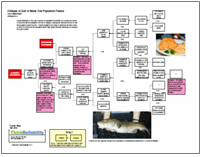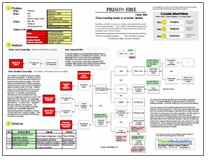By Kim Smiley
Part of the excitement involved in passenger cruises is access to remote areas of the world. However, when a ship runs in to trouble, that remoteness can result in extremely difficult conditions. This was the case on the Costa Allegra, which suffered an engine room fire in the Indian Ocean.
Passengers aboard the Costa Allegra experienced sub-standard conditions when the ship lost power and propulsion due to an engine room fire. During the three days while the ship was being towed to land, there was no air conditioning, lighting, or running water. Food and drinking water were provided by helicopter.
 We can examine the causes and effects of this issue in a Cause Map, or visual root cause analysis. With the Cause Mapping process, we begin by examining the impact to the goals. Namely, when the incident occurred, which of the organization’s goals were not met? In this case, although there appeared to be no injuries resulting from the fire itself (although some passengers may have become ill during the resulting conditions) there was the potential for severe injury resulting from the fire and then the lack of power that resulted. Additionally, the customer service goal was impacted by the lack of running water, air conditioning, and lighting. The schedule goal was impacted because the ship needed to be towed for 3 days. The property goal was impacted due to the damage to the ship from the fire, and the labor goal was impacted due to the need for the ship’s crew to stand guard against pirate attack.
We can examine the causes and effects of this issue in a Cause Map, or visual root cause analysis. With the Cause Mapping process, we begin by examining the impact to the goals. Namely, when the incident occurred, which of the organization’s goals were not met? In this case, although there appeared to be no injuries resulting from the fire itself (although some passengers may have become ill during the resulting conditions) there was the potential for severe injury resulting from the fire and then the lack of power that resulted. Additionally, the customer service goal was impacted by the lack of running water, air conditioning, and lighting. The schedule goal was impacted because the ship needed to be towed for 3 days. The property goal was impacted due to the damage to the ship from the fire, and the labor goal was impacted due to the need for the ship’s crew to stand guard against pirate attack.
Once we’ve determined the goals that were impacted, we can use them as a basis for our map, and ask “Why” questions to add more detail. Here, an engine room fire on the ship resulted in the loss of ship power, causing the loss of air conditioning, lighting and running water, and the loss of ability for the ship to propel itself, necessitating a tow. The length of the tow is also affected by the type of ship doing the towing. In this case, the first ship to arrive to the aid of the Costa Allegra was a fishing vessel. Although tugboats later arrived, the Costa Allegra requested that the fishing vessel continue the tow, although it is believed that the tugboats would have been able to speed up the tow, possibly resulting in the ship arriving as much as 12 hours earlier. The cruise ship company has stated that the tow was not changed in consideration of the consistency of the voyage for the passengers but there are also potentially financial considerations. Assistance to people at sea is not paid, but assistance to ships is. Thus, the fishing vessel actually entered into a contract with the cruise ship for the tow.
Part of the reason that a fishing vessel was the first to arrive is that there is little maritime traffic in the area. This is due to the remoteness of the area in which the cruise ship was traveling, as well as the risk of piracy. This, of course, led to a constant armed guard on the disabled ship to protect from potential pirate attack.
The location to which the ship was towed also impacts the length of the tow. It was determined that smaller ports closer to the location of the disabled Costa Allegra could not accommodate the large number of passengers on the ship, so the ship was towed to an island of Seychelles.
The cause of the fire itself is still under investigation, although it is believed that an electrical fault is a likely cause and that arson is not likely. As more information becomes available, we can add that information to the Cause Map as well.
To view the Outline and Cause Map, please click “Download PDF” above.









